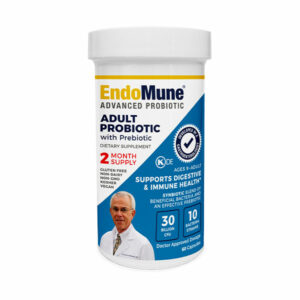Digest This
Click on the topics below to learn how probiotics can improve your digestive health, naturally.

The Best Way to Take a Probiotic
- @drHoberman
- Probiotics
The Best Way to Take a Probiotic
Thanks to the wonderful feedback we receive on our website, a growing number of you are learning why a probiotic-prebiotic combination is such a critical and valuable tool in protecting your body’s immune system from disease.
Believe me, we recognize how challenging it can be to do everything you can to ensure your gut gets the help it needs — eating nutritious, fiber-rich meals, getting the right amount of exercise and setting aside enough time for good sleep — over the course of a day to stay healthy and strong.
That’s why taking a probiotic formulated with multiple strains of live beneficial bacteria can be a critical and necessary step that gives your gut the extra help it needs to maintain that healthy balance.
Now that you have a better understanding of good gut health, you’re ready to take the next step: Learning the best way to take a probiotic.
For Adults In Good Health
Adults receive a gut-friendly boost if they take a probiotic on an empty stomach (ideally with water) about 30 minutes before eating their first meal of the day (probably a morning meal).
It’s important to give the beneficial bacteria in a probiotic some extra time to travel from the bottle to your gut without food getting in the way.
A go-to study in the health journal Beneficial Microbes concluded probiotics with multiple strains of key bacterial strains survived when taken before a meal (including strains contained in EndoMune Advanced Probiotic).
On the other hand, taking a probiotic after a meal — when your stomach acid is at its highest — is the worst time to take a probiotic because far fewer beneficial bacteria make it to your gut.
A tip: If you eat breakfast on the run, you may want to take a probiotic before you go to sleep to ensure those beneficial bacteria have the necessary time to do their work.
Whether you take a probiotic first thing in the morning or before you turn in for the night, just be consistent and take your probiotic supplement every day.
For Your Healthy Child
Young children may need some extra help, especially if their developing gut health is compromised or they’re having problems like constipation.
For children under age 3, parents can help to protect their developing immune systems and potentially reduce problems with colic by sprinkling a multi-species probiotic in powdered form (like EndoMune Junior Advanced Probiotic Powder) in a liquid or noncarbonated formula or on soft foods before or with their meal once a day.
As your child grows up and out of those toddler times, she/he will graduate to a probiotic of their own. You can make it fun for your young child with the chewy, fruity EndoMune Junior Advanced Chewable Probiotic.
For Those Sick Days
Taking a probiotic every day is really important, especially when you’re sick and taking medications like antibiotics that can upset the healthy balance of bacteria in your gut and sometimes create more problems like superbugs.
When your doctor prescribes an antibiotic, don’t be surprised if he/she suggests you take a probiotic as a way to lessen the chances of any extra problems like extra gas and bloating or diarrhea.
Be sure to give yourself a two-hour break between taking an antibiotic and probiotic. That extra gap gives those beneficial bacteria extra time to do their work.
Check in With Your Doctor
If you’re ready to begin taking a probiotic, you have one last assignment to complete: Make an appointment to see your primary care physician.
Consulting with your doctor is really important, especially if you’re taking medications (antifungals or immunosuppressants) for specific conditions every day, to ensure your body can handle a probiotic.
References
There Is An Endomune Probiotic For Every Lifestyle
-
EndoMune Metabolic Rescue
$44.95 -
EndoMune Advanced Probiotic
$42.95 -
EndoMune Companion Pack
$112.93








